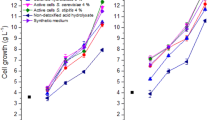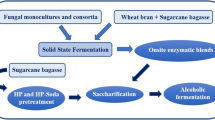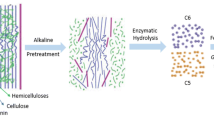Abstract
The objective of this study was to evaluate the ethanol production from the sugars contained in the sugarcane bagasse hemicellulosic hydrolysate with the yeast Pichia stipitis DSM 3651. The fermentations were carried out in 250-mL Erlenmeyers with 100 mL of medium incubated at 200 rpm and 30 °C for 120 h. The medium was composed by raw (non-detoxified) hydrolysate or by hydrolysates detoxified by pH alteration followed by active charcoal adsorption or by adsorption into ion-exchange resins, all of them supplemented with yeast extract (3 g/L), malt extract (3 g/L), and peptone (5 g/L). The initial concentration of cells was 3 g/L. According to the results, the detoxification procedures removed inhibitory compounds from the hemicellulosic hydrolysate and, thus, improved the bioconversion of the sugars into ethanol. The fermentation using the non-detoxified hydrolysate led to 4.9 g/L ethanol in 120 h, with a yield of 0.20 g/g and a productivity of 0.04 g L−1 h−1. The detoxification by pH alteration and active charcoal adsorption led to 6.1 g/L ethanol in 48 h, with a yield of 0.30 g/g and a productivity of 0.13 g L−1 h−1. The detoxification by adsorption into ion-exchange resins, in turn, provided 7.5 g/L ethanol in 48 h, with a yield of 0.30 g/g and a productivity of 0.16 g L−1 h−1.


Similar content being viewed by others
References
Conab (Companhia Nacional de Abastecimento). Retrieved September 2009 from www.conab.gov.br.
Cenbio (Centro Nacional de Referência em Biomassa). Retrieved August 2003 from www.cenbio.org.br.
Fapesp (Fundação de Amparo a Pesquisa do Estado de São Paulo). Propriedades do bagaço da cana-de-açúcar. Revista Pesquisa FAPESP, 30ª ed., Abril 1998.
Sun, J. X., Sun, X. F., Zhao, H., & Sun, R. C. (2004). Polymer Degradation and Stability, 84, 331–339.
Selman-Housein, G., López, M. A., Ramos, O., Carmona, E. R., Arencibia, A. D., Menéndez, E., et al. (2000). Developments in Plant Genetics and Breeding, 5, 189–193.
Baudel, H. M., Zaror, C., & Abreu, C. A. M. (2005). Industrial Crops and Products, 21, 309–315.
Cerqueira Leite, R. C., Leal, M. R. L. V., Cortez, L. A. B., Griffin, W. M., & Scandiffio, M. I. G. (2009). Energy, 34, 655–661.
Pandey, A., Soccol, C. R., Nigam, P., & Soccol, V. T. (2000). Bioresource Technology, 74, 69–80.
Aguilar, R., Ramírez, J. A., Garrote, G., & Vásquez, M. (2002). Journal of Food Engineering, 55, 304–318.
Carvalho, W., Batista, M. A., Canilha, L., Santos, J. C., Converti, A., & Silva, S. S. (2004). Journal of Chemical Technology and Biotechnology, 79, 1308–1312.
Silva, S. S., Matos, Z. R., & Carvalho, W. (2005). Biotechnology Progress, 21, 1449–1452.
Felipe, M. G. A. (2004). In B. C. Saha & K. Hayashi (Eds.), Lignocellulose biodegradation, ADC Symposium series 889. Washington: American Chemical Society, pp. 300–315.
Palmqvist, E., & Hahn-Hagerdal, B. (2000). Bioresource Technology, 74, 17–24.
Carvalho, W., Santos, J. C., Canilha, L., Almeida e Silva, J. B., Felipe, M. G. A., Mancilha, I. M., et al. (2004). Process Biochemistry, 39, 2135–2141.
Eken-Saraçoglu, N., & Arslan, Y. (2000). Biotechnological Letters, 22, 855–858.
Martinez, A., Rodriguez, M. E., Wells, M. L., York, S. W., Preston, J. F., & Ingram, L. O. (2001). Biotechnology Progress, 17, 287–293.
Lee, W. G., Lee, J. S., Shin, C. S., Park, S. C., Chang, H. N., & Chang, Y. K. (1999). Applied Biochemistry and Biotechnology, 77–79, 547–559.
Mussatto, S. I., & Roberto, I. C. (2001). Biotechnological Letters, 23, 1681–1684.
Carvalho, W., Canilha, L., Mussatto, S. I., Dragone, G., Morales, M. L. V., & Solenzal, A. I. N. (2004). Journal of Chemical Technology and Biotechnology, 79, 863–868.
Villarreal, M. L. M., Prata, A. M. R., Felipe, M. G. A., & Almeida e Silva, J. B. (2006). Enzyme Microbial Technology, 40, 17–24.
Alves, L. A., Felipe, M. G. A., Almeida e Silva, J. B., Silva, S. S., & Prata, A. M. R. (1998). Applied Biochemistry and Biotechnology, 70-72, 89–98.
Canilha, L., Almeida e Silva, J. B., & Solenzal, A. I. N. (2004). Process Biochemistry, 39, 1909–1912.
Browning, B. L. (1967). Method of wood chemistry. New York: Wiley.
Nigam, J. N. (2002). Journal of Biotechnology, 97, 107–116.
Hahn-Hägerdal, B., Jeppsson, H., Olsson, L., & Mohagheghi, A. (1994). Applied Microbiology and Biotechnology, 41, 62–72.
Nigam, J. N. (2001). Journal of Biotechnology, 87, 17–27.
Nilvebrant, N. O., Reimann, A., Larsson, S., & Jonsson, L. J. (2001). Applied Biochemistry and Biotechnology, 91–93, 35–49.
Carvalheiro, F., Duarte, L. C., Lopes, S., Parajó, J. C., Pereira, H., & Gírio, F. M. (2005). Process Biochemistry, 40, 1215–1223.
Chandel, A. K., Kapoor, R. K., Singh, A., & Kuhad, R. C. (2007). Bioresource Technology, 98, 1947–1950.
Karimi, K., Emtiazi, G., & Taherzadeh, M. J. (2006). Process Biochemistry, 41, 653–658.
Cheng, K. K., Cai, B. Y., Zhang, J. A., Ling, H. Z., Zhou, Y. J., Ge, J. P., et al. (2008). Biochemical Engineering Journal, 38, 105–109.
Larsson, S., Reimann, A., Nilvebrant, N., & Jönsson, L. J. (1999). Applied Biochemistry and Biotechnology, 77–79, 91–103.
Gupta, R., Sharma, K. K., & Kuhad, R. C. (2009). Bioresource Technology, 100, 1214–1220.
Sreenath, H. K., & Jeffries, T. W. (2000). Bioresource Technology, 72, 253–260.
Marques, S., Alves, L., Roseiro, J. C., & Girio, F. M. (2008). Biomass Bioenergy, 32, 400–406.
Silva, J. P. A. (2007). Master dissertation, Universidade de São Paulo, Escola de Engenharia de Lorena, Lorena, São Paulo, Brazil.
Roberto, I. C., Lacis, L. S., Barbosa, M. F. S., & Mancilha, I. M. (1991). Process Biochemistry, 26, 15–21.
Telli-Okur, M., & Eken-Saraçoglu, N. (2008). Bioresource Technology, 99, 2162–2169.
Acknowledgments
The authors are grateful to FAPESP and CNPq for financial support.
Author information
Authors and Affiliations
Corresponding author
Rights and permissions
About this article
Cite this article
Canilha, L., Carvalho, W., de Almeida Felipe, M.d. et al. Ethanol Production from Sugarcane Bagasse Hydrolysate Using Pichia stipitis . Appl Biochem Biotechnol 161, 84–92 (2010). https://doi.org/10.1007/s12010-009-8792-8
Received:
Accepted:
Published:
Issue Date:
DOI: https://doi.org/10.1007/s12010-009-8792-8




